Mirella Sichirollo Patzer's Blog, page 37
August 7, 2012
The Wild Princess by Mary Hart Perry

An intriguing look at the feisty daughter of Queen Victoria!
Book Description:
Four of the five daughters of England's Queen Victoria and Prince Albert were regal, genteel, and everything a princess should be. But one was rebellious, scandalous, and untamed.
This is her story. . . .
To the court and subjects of Queen Victoria, young Princess Louise—later the Duchess of Argyll—was the "Wild One." Proud and impetuous, she fought the constraints placed on her and her brothers and sisters, dreamed of becoming an artist, and broke with a three-hundred-year-old tradition by marrying outside of the privileged circle of European royals. Some said she wed for love. Others whispered of a scandal covered up by the Crown. It will take a handsome American, recruited by the queen's elite Secret Service, to discover the truth. But even as Stephen Byrne—code name the Raven—vows to risk his life to protect the royal family from violent Irish radicals, he tempts Louise with a forbidden love that could prove just as dangerous.
In the vein of Philippa Gregory, Mary Hart Perry tells the riveting story of an extraordinary woman—a princess who refused to give up on her dreams, including her right to true love.
Book Review:
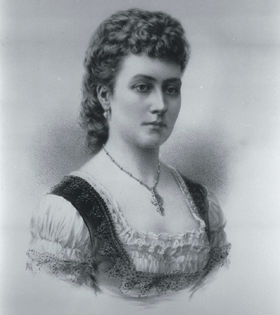
Princess Louise
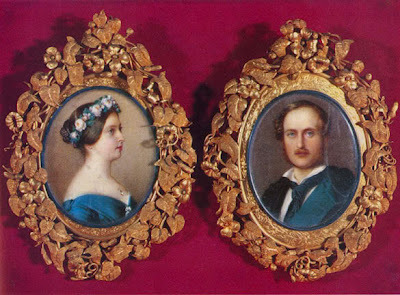
Queen Victoria and Prince Albert
Princess Louise was the daughter of Queen Victoria and Prince Albert. She was their 6th child and 4th daughter. Because Louise was born at a time when numerous revolutions were taking place in Europe, Queen Victoria believed Louise would be "peculiar".
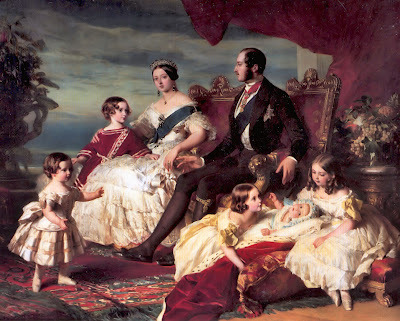
Princess Louise is the infant on the right next to the eldest child
And this proved very true. Of all Victoria's children, Louise was the most unconventional, dubbed the wild child. She wanted to be normal and did not flaunt her noble status. This made relations between her and her mother often strained. The more Queen Victoria tried to control her, the more she fought back.
As always, when reading historical fiction, fiction is weaved with fact. In the case of this novel, the author followed Louise's life closely, except for the romance with Stephen. Stephen is a stetson wearing, American body guard who works for Queen Victoria and her family, and a complete fictional character. However, readers will find that most of the story line is remarkably accurate and true to the times.
Louise is depicted as wilful, imaginative, feisty, and self-confident. And definitely a true beauty! It was refreshing to see how Louise viewed her life as restricted and smothering. She envied others for being able to walk freely about in public or go to whatever schools is preferred. The imagery and descriptions of surroundings was very well writen, as was the characterization. The author writes with plenty of emotion and does an excellent job of bringing Princess Louise to life.
The Wild Princess is one of a series of novels the author is writing about the daughters of Queen Victoria. Unique and compelling, I thoroughly enjoyed this book and eagerly await the next novel to be released.
I LOVE COMMENTS

From History and Women









Published on August 07, 2012 14:31
August 5, 2012
THE EMPRESS THEODORA - THE WORLD'S FIRST FEMINIST
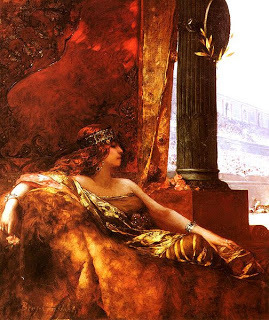
She was born in the year 500, though history
is unsure where. Her father trained bears; her mother danced bare. Yet she grew
up to marry an Emperor and become one of the most renowned and respected women
in history.
The main historical reference for her life is
a contemporary scribbler called Procopius; he wrote three accounts of her life,
and they all contradicted each other. So our main source is completely unreliable.
But we do know that when her father died, Theodora, her mother and her two
sisters were rendered destitute and that
she and her three sisters followed her mother into a Constantinople brothel.
The terms of her employment would have included exotic dancing on stage and
providing sexual services off it.
According to Procopius she made a name for herself with her portrayal of
Leda and the Swan, first performing a striptease, then lying on her back while her
support act scattered seeds on her body. A flock of geese were then brought in
to peck them off her. A sort of corn porn.
But Procopius goes further, alleging that she entertained ten men at a
time, and when she’d exhausted them would then satisfy their thirty slaves as
well. And though she flung wide three gates to the ambassadors of Cupid, she
lamented that nature had not similarly unlocked the straits of her bosom, that
she might there have contrived a further welcome to his emissaries.
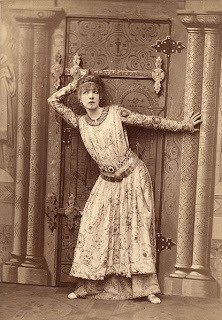
Theodora doing a Sarah Bernhardt
I’m not sure I believe him there. He sounds very
much like a rancorous or jilted lover.
What we do know is that at sixteen she
accompanied a functionary called Hecebolus to North Africa where he took up the
position of governor of Pentapolis. But he beat and abused her so after
four years she left him and lived for a while in Alexandria, where she
converted to Christianity.
So when she returned to Constantinople in 522 she gave up geese and pierced
bosoms and settled for life spinning wool near the palace. It was here that she
attracted the attention of the emperor’s nephew, Justinian. It wasn’t a casual
affair; Theodora was not only beautiful, she was also smart and amusing and he
wanted to marry her. But the law forbade high born men marrying actresses -
even after they had renounced geese.
So when Justinian took the throne in 525, he simply
repealed the law.
He showed great foresight. Historians agree that it was Theodora's
courage and decisiveness that later saved Justinian's reign.
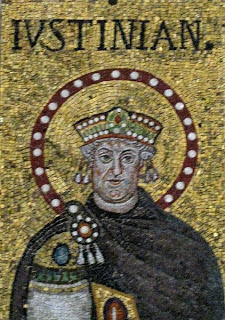
photograph: Testus
During the Nika riots in 532, a huge mob ran
amok in the city, and were about to proclaim a new emperor, Hypatius. Justinian
prepared to flee Constantinople. But at a meeting of the government council,
Theodora urged him to fight it out, reminding him that "purple makes a
fine shroud" - meaning it would be better to die fighting as an emperor
than to run away and live the rest of his life as an exile.
Justinian rediscovered his nerve. He ordered his loyal troops to attack
the demonstrators in the Hippodrome and after fierce fighting they killed over
thirty thousand of them.
He kept his purple and never forgot that it was Theodora who had saved
his throne.
After the revolt, Justinian rebuilt Constantinople and made it the most
splendid city in the world; even today the Hagia Sophia remains one of the great
architectural wonders.
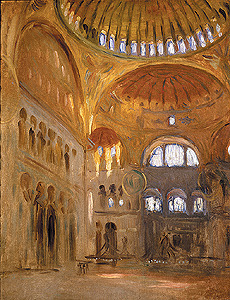
He treated Theodora as his equal and she used her influence to affect real
change in the empire. She had laws passed that prohibited forced prostitution;
she created a convent called the Metanoia (Repentance), where the
ex-prostitutes could support themselves. She also expanded the rights of women
in divorce and property ownership; instituted the death penalty for rape; and
established basic property rights for women right across the Eastern Empire.
She also forbade the killing of a wife who committed adultery - a custom that had
been legal until then.
It is why she is now considered perhaps the greatest woman in the history
of the Roman Empire. As a result of her efforts, the status of women in the
Byzantine Empire was elevated far above that of women in the Middle East and
the rest of Europe.
Theodora died of an unspecified cancer on 28 June 548 at the age of 48;
Justinian wept bitterly at her funeral. It was a remarkable life and a
remarkable legacy; and sadly, her reforms are as badly needed in much of
the world even today as they were then.

See Colin Falconer's HAREM here
See more history at
Looking for Mr Goodstory here.
I LOVE COMMENTS

From History and Women









Published on August 05, 2012 07:29
August 2, 2012
A Winter's Day: A Restoration Tragedy by Bunny Paine-Clemes

It is 1666 and young heiress Elizabeth Mallet is in London, stifled by the restrictions imposed by her family and unimpressed by the suitors her mother is trailing in front of her. Yet Elizabeth is convinced that it is her destiny to find, in this thrilling capital city, a man of passion and excitement, the man who will be her soulmate. When she meets the dashing but penniless John Wilmot, Earl of Rochester, her heart is instantly lost to him and she must make him hers. This spellbinding romance takes place at the heart of bawdy Restoration London, against a backdrop of momentous events in English history: the Plague, the Great Fire and war against the Dutch. Will the determined Elizabeth get what she so desires wedded bliss in an era of loose social mores and strategic marital liaisons? Or will the promiscuous Rochester's seeming dread of marriage end up leaving her frustrated and broken-hearted? This intimate and intricate historical tragic-comedy will transport you back to the Devil's year and the romance of the century.
In the novel, A WINTER’S DAY: A RESTORATION TRAGEDY, author Bunny Paine-Clemes acquaints readers with two fascinating characters who lived during England’s restoration period – John Wilmot, the 2nd Earl of Rochester and Elizabeth Mallet, a wealthy heiress from a noble family.

John Wilmot
Second Earl of Rochester
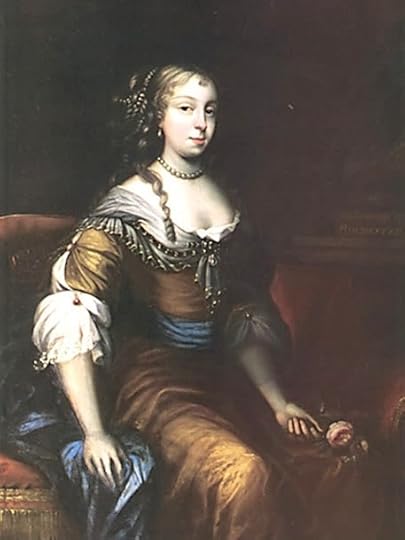
Elizabeth Mallet
Countess of Rochester
Elizabeth’s mother and grandfather are avidly searching for a suitable husband her to wed. In a chance meeting, Elizabeth encounters John Wilmot, a charismatic and charming impoverished earl with a reputation for riotous behavior, rampant drunkenness, spirited dialogue, and outrageous frolics; a notorious lady’s man known for his numerous love affairs and sexual encounters. Elizabeth falls hopelessly in love, but Elizabeth’s guardians strongly disapprove and endeavour to keep her separated and far away from wicked earl.
As the couple become more earnest in finding ways to come together, their passion increases, culminating in the earl abducting her. Of course, he is soon caught and imprisoned in infamous Tower of London. A favourite of the king, John is not treated too harshly and is soon released and forgiven. To redeem himself, he sets off for war where his bold courage results in extremely heroic acts, adding to his colorful reputation.
Along with Elizabeth and John, the author adds a host of historical figures from the time – especially John’s friends and the king, who support and guide him along the way.
What I loved most about this novel was the author’s portrayal of the extremely sexy, magnetic, and alluring John Wilmot. From his incredibly quippy and sharp dialogue, to his lovably bold and confident romantic antics, I was completely absorbed by this enigmatic man. I could not wait to turn the pages to find out what he would do or say next. I cannot say enough about how exceptional the author’s depiction of him his. By far one of the best characterizations of a romantic hero I have ever read.
Equally fabulous was the development of the heroine, Elizabeth Mallet. Her growing love for the earl was written in a credible, realistic fashion. A woman trapped by social convention, she was feisty enough to follow her heart and do everything she could to be with the man she loved despite the entire world discouraging her from him.
This was a brilliant retelling of the lives of two lesser-known historical figures and well worth reading. My only caveat is to be prepared for antique language, which took some getting used to – words like hither and thither, hence and whence, and many other old English words no longer in use today. Although they lend spice and authenticity, they were a bit distracting and made for a challenging read. Nevertheless, this is a brilliantly written novel, authentic and true to the times, and extremely well researched. I very highly recommend it! Fabulous, truly fabulous!
;
I LOVE COMMENTS

From History and Women









Published on August 02, 2012 10:04
August 1, 2012
Women Who Ruled: Mahpeyker Kosem Sultan of Ottoman Turkey
By Lisa J. Yarde
For women who ruled, it seemed as if power and enduring
happiness could not often coexist. While they lived, these women proved they
could be as competent, decisive, and cruel when necessary, similar to their
male counterparts.

Imperial Hall, Topkapi Palace
In the seventeenth
century, Sultan Mehmed III fathered a son, Ahmet I, who became ruler of the
Ottoman Empire in 1603, at the age of thirteen. Until then, Ahmet had spent
several years in isolation within Topkapi Palace's Golden Cage, an apartment reserved for princes younger than the reigning sovereign. Two years later, a fifteen
year-old Greek girl born in 1590 entered his harem, a slave re-named Kosem. Daughter of a priest, Kosem entered the harem and in
1612, bore him their first son, Murad. She later became the mother of the
princes Ibrahim and Bajezit.
Ahmet died in 1617
and his younger brother, Mustafa I, succeeded him. All that time in the Golden
Cage in his youth made Mustafa crazy. Courtiers deposed him twice before
Kosem's son, Murad IV, came to the throne in 1623 at the age of eleven. His
youth required the appointment of the Valide Sultan Kosem as his official
regent. Kosem advised her son at meetings of the Sultan's ministers from behind a curtain while she remained secluded from view. It was the first time in Ottoman history where a woman played such a prominent, official role. During Murad’s reign she gained the official title of Mahpeyker Kosem Sultan.
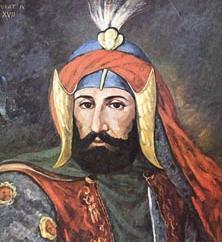
Sultan Murad IV
Murad proved to be a
cruel ruler in his majority, prohibiting drinking and smoking upon pain of
death, while he indulged in both habits. His younger brother Ibrahim soon
showed signs of the same madness that affected Mustafa I. Kosem's hope that her
remaining son Bajezit might succeed his incompetent brother ended when Murad
ordered Bajezit's death after losing a contest to him. Murad died in 1640 at
the age of 27 due to cirrhosis of the liver from his excessive drinking. Before his passing, he gave one final order: the death of his surviving brother Ibrahim. Kosem prevented the murder and coaxed a fearful Ibrahim out of the Golden Cage. His ineptitude allowed her to oversee the empire again.
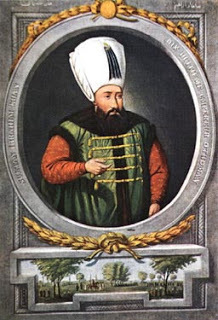
Sultan Ibrahim I
Though her third son was mentally unstable, it served Kosem's interests to have Ibrahim inherit the throne. While the incompetent Sultan loitered around the palace feeding coins to fish, urging his agents to purchase furs and fill his harem with the most obese women they could find, Kosem continued to rule. Even after Ibrahim's death in a palace coup in 1648, Kosem refused to surrender the regency to Turhan, the Russian mother of her seven-year old grandson Mehmed IV. In 1651, Kosem began plotting the removal and replacement of the sultan, but the conspiracy failed without the support of the army. Harem servants strangled Kosem. Three days of official
mourning followed her death.
The life of Kosem is celebrated in the 2010 Turkish film, Mahpeyker - Kosem Sultan.
I LOVE COMMENTS

From History and Women










For women who ruled, it seemed as if power and enduring
happiness could not often coexist. While they lived, these women proved they
could be as competent, decisive, and cruel when necessary, similar to their
male counterparts.

Imperial Hall, Topkapi Palace
In the seventeenth
century, Sultan Mehmed III fathered a son, Ahmet I, who became ruler of the
Ottoman Empire in 1603, at the age of thirteen. Until then, Ahmet had spent
several years in isolation within Topkapi Palace's Golden Cage, an apartment reserved for princes younger than the reigning sovereign. Two years later, a fifteen
year-old Greek girl born in 1590 entered his harem, a slave re-named Kosem. Daughter of a priest, Kosem entered the harem and in
1612, bore him their first son, Murad. She later became the mother of the
princes Ibrahim and Bajezit.
Ahmet died in 1617
and his younger brother, Mustafa I, succeeded him. All that time in the Golden
Cage in his youth made Mustafa crazy. Courtiers deposed him twice before
Kosem's son, Murad IV, came to the throne in 1623 at the age of eleven. His
youth required the appointment of the Valide Sultan Kosem as his official
regent. Kosem advised her son at meetings of the Sultan's ministers from behind a curtain while she remained secluded from view. It was the first time in Ottoman history where a woman played such a prominent, official role. During Murad’s reign she gained the official title of Mahpeyker Kosem Sultan.

Sultan Murad IV
Murad proved to be a
cruel ruler in his majority, prohibiting drinking and smoking upon pain of
death, while he indulged in both habits. His younger brother Ibrahim soon
showed signs of the same madness that affected Mustafa I. Kosem's hope that her
remaining son Bajezit might succeed his incompetent brother ended when Murad
ordered Bajezit's death after losing a contest to him. Murad died in 1640 at
the age of 27 due to cirrhosis of the liver from his excessive drinking. Before his passing, he gave one final order: the death of his surviving brother Ibrahim. Kosem prevented the murder and coaxed a fearful Ibrahim out of the Golden Cage. His ineptitude allowed her to oversee the empire again.

Sultan Ibrahim I
Though her third son was mentally unstable, it served Kosem's interests to have Ibrahim inherit the throne. While the incompetent Sultan loitered around the palace feeding coins to fish, urging his agents to purchase furs and fill his harem with the most obese women they could find, Kosem continued to rule. Even after Ibrahim's death in a palace coup in 1648, Kosem refused to surrender the regency to Turhan, the Russian mother of her seven-year old grandson Mehmed IV. In 1651, Kosem began plotting the removal and replacement of the sultan, but the conspiracy failed without the support of the army. Harem servants strangled Kosem. Three days of official
mourning followed her death.
The life of Kosem is celebrated in the 2010 Turkish film, Mahpeyker - Kosem Sultan.
I LOVE COMMENTS

From History and Women









Published on August 01, 2012 06:00
July 31, 2012
Once More From the Beginning by Wendy Bertsch
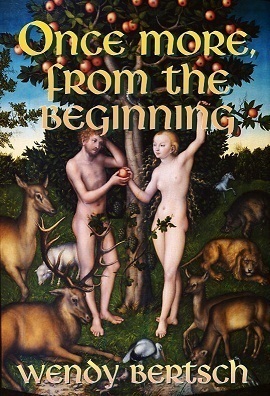 Here’s a new look at the Old Testament...but this
Here’s a new look at the Old Testament...but thistime the women’s voice gets the prominence it deserves. Always witty, often
funny, and definitely never boring, the women’s common sense outlook puts quite
a different spin on the stories you think you remember. The men have had their
way with history for far too long. Let’s see that ancient world through a
woman’s eyes. You may be surprised!
Published on July 31, 2012 08:35
July 26, 2012
IF ROMEO AND JULIET GOT MARRIED
THE WOMAN BEHIND LOVE'S GREATEST MONUMENT
Colin Falconer
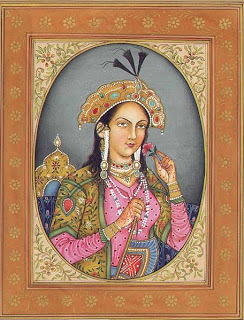
Mumtaz Mahal
In the west we think of Romeo and Juliet as the archetypal lovers, the
ultimate romantic couple. Yet India has perhaps better claim to the accolade
than Italy; if you want to find a monument to the world's greatest love story, you will
find it in one of India’s most polluted and industrialized cities, not the cobbled
medieval streets of Verona.
India’s Juliet was born Arjumand
Banu Begum, in Agra, northern India, the niece of the Empress Nur Jehan, wife
of the Emperor Jehangir. She was fourteen years old when she was engaged to
Prince Khurram - later to become the Shah Jahan. But she had to wait five years
for the marriage, for a date chosen by court astrologers as propitious for a
happy marriage.
For once, the court
astrologers got it exactly right.
In the intervening years the Shah had already taken two other wives; but after he married Arjumand he was so taken with her that he surrendered
his polygamous rights to other women in order to be only with her. He later
conferred upon her the title ‘Mumtaz Mahal’ - the chosen one of the palace.
According to the official court chronicler, Motamid Khan, the relationship
with his other wives ‘had nothing more than the status of marriage. The
intimacy, deep affection, attention and favour which His Majesty had for the
Cradle of Excellence (Mumtaz) exceeded by a thousand times what he felt for any
other.’
Of course, the affections of princes can be notoriously fickle; but not in the case of
Shah Jahan.
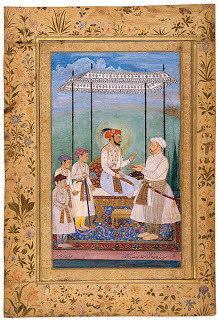
Mumtaz became his trusted companion, and travelled with him everywhere, even
on military campaigns, despite her frequent pregnancies. Court historians go to elaborate lengths to document the
intense and erotic relationship the couple enjoyed. His trust in her was so profound
that he even gave her his imperial seal, the Murh Uzah.

Burhanpur: photograph Md iet
In their nineteen years of marriage she bore him thirteen children, seven of
whom died at birth or at a very young age. But in 1631, while him accompanying on a
military expedition in Burhanpur (now in Madhya Pradesh) she died while giving
birth to their fourteenth child, a daughter named Gauhara.
The Shah was reportedly inconsolable. He went into secluded mourning for a
year and when he appeared again, his hair had turned white.
The first half of his life had been dedicated to their marriage; the second
half of it he dedicated to her memorial.
In 1631 he had
her body disinterred and transported in a golden casket back to Agra. He then set to work planning
the design and construction of a suitable mausoleum and funerary garden for the woman who was the love of his life. It was
a task that would take more than 22 years to complete: he was
still laboring over her tomb in his fifties.

the Taj Mahal
He had translucent white
marble brought from Rajasthan; jade and crystal from China; turquoise from Tibet;
carnelian from Arabia. He brought in the finest artisans in the Empire.
There were sculptors from Bukhara, calligraphers from Syria and Persia,
stonecutters from Baluchistan.
When it was finished it became one of the wonders of the world and remains the
iconic
emblem of India; the Taj Mahal.

But the construction bankrupted the Empire and soon after its completion, he
was deposed by his son Aurangzeb and put under house arrest at nearby Agra
Fort.
It is said that he could not see the Taj from his cell so he hung a
crystal in the high window so he could see its reflection there. When he died, Aurangzeb
buried him in the mausoleum next to his wife.
Theirs
was one of the great love stories of history. And as the four million tourists
who flock to Agra every year will attest, it was indeed a love that did not grow old.

See Colin Falconer's HAREM here.
See more history at
Looking for Mr Goodstory here.
I LOVE COMMENTS

From History and Women









Published on July 26, 2012 18:18
July 24, 2012
A Humble Companion by Laurie Graham
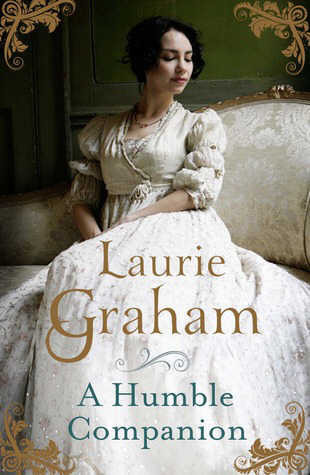
Book Summary
Meet Nellie Welche - companion to royalty and keeper of secrets ... Nellie Welche is the daughter of a high-ranking steward in the household of Prinnie, Prince of Wales. In 1788, at the age of twelve, she's proposed as a suitably humble companion to Princess Sophia, one of George III's enormous brood of children. Nellie and Sofy become friends for life. From the first rumblings of revolution in France to the exciting, modern times of gas light and steam trains, from poor mad George to safe and steady Victoria, Nellie is the sharp-penned narrator of a changing world and the unchanging, cloistered lives of Princess Sofy and her sisters. Nellie proves to be more a hawk-eyed witness than a Humble Companion, as her memoir lifts the lid on the House of Hanover's secrets and lies.
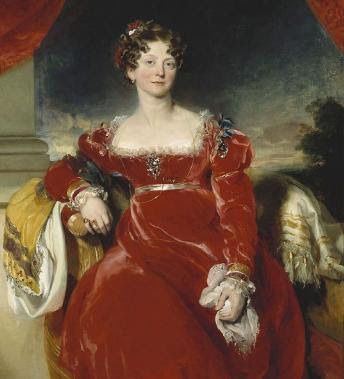
Princess Sofy
Review
A Humble Companion by Laurie Graham is a novel about the Royal Family in the 18th to 19th centuries, from the reign of King George III to Queen Victoria. The story begins in 1788. Nellie Welche is a twelve year old girl with a horrible birthmark on her face. She lives a comfortable life home in Soho with her parents. Her father, a chef for the household of the Prince of Wales, suggests to the King that Nellie might make a suitable companion to nine year old Princess Sophia, the daughter of King George III and Queen Charlotte.

King George III

Queen Charlotte
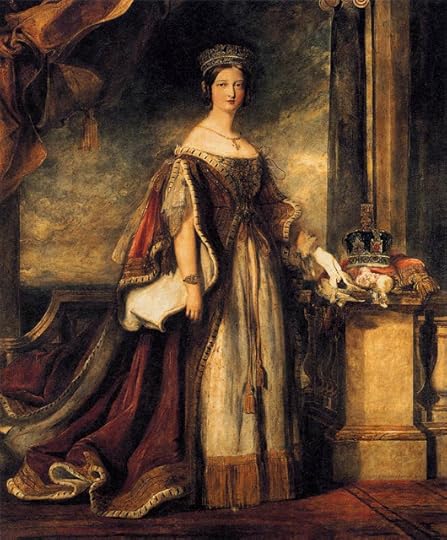
Queen Victoria
Nellie is thrust into the opulent, but restrictive world of the royal children. As the girls grow up together, they experience life together, love, marriage, childbirth, and death. Nellie soon comes to understand that a privileged, glamorous life as a member of the royal family is not as desirable as she once thought.
Author Laurie Graham skilfully inter-weaves an interesting tale through the turbulence of the 18th century, a time of extreme suffering, restrictions, poverty, and privilege. I thoroughly enjoyed the contrast between Nellie's independence and the restrictions Sofy must learn to live within. This is definitely a character driven novel with a strong vein of historical fact woaven throughout. For this reason, I found the characters and story very believable, informative, and realistic in every way. I especially enjoyed the way the author dealt with King George's fluctuations between madness and coherent stability - respectful and touching, especially how it impacted his wife and family. For anyone who loves novels about the English Royalty who want a factual, realistic portrayal, then this is definitely a book to get. Extremely enjoyable.
I LOVE COMMENTS

From History and Women









Published on July 24, 2012 15:59
July 21, 2012
THE FACE THAT LAUNCHED A THOUSAND SHIPS
HELEN OF TROY
by
Colin Falconer
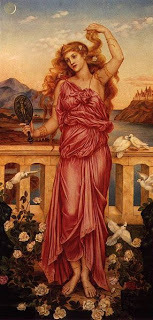
The face that launched a thousand ships?
Beauty, passion, jealousy, corruption,
treachery, lust.
It could be just another
day in Washington or Hollywood; instead these are the key ingredients in a story
that happened over three thousand years ago, in the Middle East.
The tale was inspired by one of the most beautiful and enigmatic characters in all history; her name was
Helen.
She was to become a symbol for all mens' erotic desires, her legend intricately
and intimately entwined with that of the Greek pantheon.
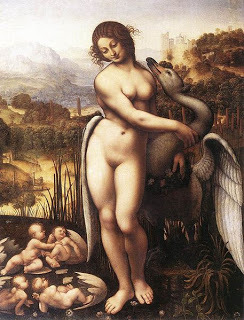
Her father was Tyndareus,
King of Sparta. Or was he? Others say she was sired by a god, one dedicated to the
torment of all mankind - Zeus. It is said that he slept
with her father’s queen, Leda, while disguised as a swan.
Another legend claims
her mother was the goddess Nemesis, who turned into a goose to try and escape Zeus's attentions. So he transformed himself into a swan in order to ravish her. She then left the egg
with Leda.
But however she was conceived, she grew to become the most beautiful woman
in the world; and when she was of a marriageable age, Tyndareus looked for a
suitable husband for her.
Every prince and hero in the Greek world competed for
her hand and with great prescience, Tyndareus made them all swear an oath to assist
the eventual winner should Helen ever be stolen.
He then sold her to the highest bidder - Menelaos.
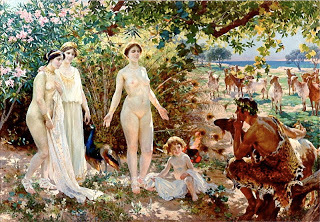
But Zeus had not finished plotting. He organized a beauty contest among
three rival goddesses; Hera, Athena and Aphrodite. He then named a mortal
Trojan prince named Paris as the judge.
But it is with gods as it is with us; the fix was soon in. All three
girls tried to bribe him to choose them as the winner. Hera promised him power;
Athena promised him wealth; Aphrodite promised him the most beautiful woman in
the world.
Paris chose Aphrodite and she rewarded him with Helen as her part
of the bargain. It didn’t matter to her that Helen was married - that was a problem for
mortals, not for gods.

was it like this ...?
Paris went to Sparta under the guise of a
diplomatic mission and when Menelaos left for a brief visit to Crete, he
claimed his prize and abducted Helen. Some
stories say Helen went willingly, seduced by Paris's charms; others claim that
he kidnapped and raped her.
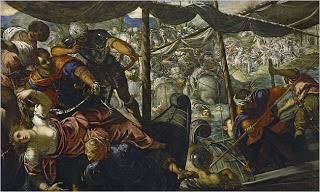
... or like this?
Whatever the truth, when Menelaos discovered that his wife was missing,
he was enraged by this abuse of his hospitality. He called upon all the
other Greek princes to fulfill the oaths they had made, and help him get her back.
An armada set
sail for Troy - Helen thus became 'the face that launched a thousand ships.'
The war against Troy lasted 10 years, and laid waste the surrounding land, (now part of
western Turkey), costing thousands of lives. During this time Helen grew disenchanted
with Paris; his brother, Deiphobus, took her as his paramour when Paris was
killed.
In the Iliad, Homer paints Helen as a poignant and tragic
figure, filled with self loathing for the destruction she has caused. The Trojans have come to hate her: ‘no
longer have I anyone beside in broad Troy that is gentle to me or kind; but all
men shudder at me.’

the fall of Troy
Other ancient writers describe her as treacherous, claiming she signaled to
the Greeks when the Trojan Horse was admitted to the city, and then hid her new
husband's sword when the city was overrun, thus leaving him to the mercy of
Menelaos.
When Menelaos finds her, he raises his sword to kill her; but,
at that moment she lets slip her robe and the sight of her beauty makes him drop
his sword, all thoughts of revenge forgotten.
Her fate is cloudy; some say she sailed back to Greece
and lived a long and happy life as the wife of Menelaos; others that she sought exile on Rhodes, and was lynched.
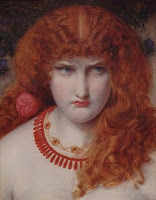
'What part of "I want a pony" don't you understand?
Her precise role in the fall of Troy is a matter of legend rather than
historical fact. In this way, the interpretation of her role has served as a mirror to society’s
view of women through history, rather than a view of Helen herself.
Since ancient times she was blamed for her extraordinary
beauty and the effect it had on men. Beauty then was her curse, while it was also vindication for the actions of the men around her.
But when we look at the story and Helen’s
actions, none of it was her doing; she was first sold to the highest bidder by her father, then abducted
from her home at the behest of the gods. The story makes her never more than a puppet in
the machinations of men and of heaven.
Yet she is portrayed as the type of woman that all other women should envy and therefore hate; and that all men should fear and yet desire.
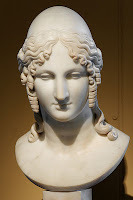
photograph: Marie-Lan Nguyen
The story thus remains as fresh and relevant
today as it was three and a half thousand years ago, when it was whispered
around the fires of more ancient times.
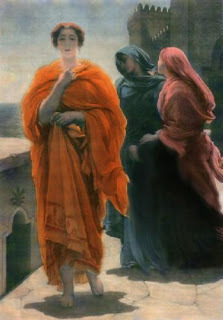
"Was this the face that launch'd a thousand ships ...
Sweet Helen,
make me immortal with a kiss."
... Christopher Marlowe (Faust, 1604)
Does beauty bestow immortality and happiness? If we look into the haunted
face of Helen of Troy, we find our answer.
Hers is indeed one of the greatest
stories ever told.

See Colin Falconer's latest novel, Anastasia, here,
and more history from Colin Falconer at
LOOKING FOR MR GOODSTORY
I LOVE COMMENTS

From History and Women










by
Colin Falconer

The face that launched a thousand ships?
Beauty, passion, jealousy, corruption,
treachery, lust.
It could be just another
day in Washington or Hollywood; instead these are the key ingredients in a story
that happened over three thousand years ago, in the Middle East.
The tale was inspired by one of the most beautiful and enigmatic characters in all history; her name was
Helen.
She was to become a symbol for all mens' erotic desires, her legend intricately
and intimately entwined with that of the Greek pantheon.

Her father was Tyndareus,
King of Sparta. Or was he? Others say she was sired by a god, one dedicated to the
torment of all mankind - Zeus. It is said that he slept
with her father’s queen, Leda, while disguised as a swan.
Another legend claims
her mother was the goddess Nemesis, who turned into a goose to try and escape Zeus's attentions. So he transformed himself into a swan in order to ravish her. She then left the egg
with Leda.
But however she was conceived, she grew to become the most beautiful woman
in the world; and when she was of a marriageable age, Tyndareus looked for a
suitable husband for her.
Every prince and hero in the Greek world competed for
her hand and with great prescience, Tyndareus made them all swear an oath to assist
the eventual winner should Helen ever be stolen.
He then sold her to the highest bidder - Menelaos.

But Zeus had not finished plotting. He organized a beauty contest among
three rival goddesses; Hera, Athena and Aphrodite. He then named a mortal
Trojan prince named Paris as the judge.
But it is with gods as it is with us; the fix was soon in. All three
girls tried to bribe him to choose them as the winner. Hera promised him power;
Athena promised him wealth; Aphrodite promised him the most beautiful woman in
the world.
Paris chose Aphrodite and she rewarded him with Helen as her part
of the bargain. It didn’t matter to her that Helen was married - that was a problem for
mortals, not for gods.

was it like this ...?
Paris went to Sparta under the guise of a
diplomatic mission and when Menelaos left for a brief visit to Crete, he
claimed his prize and abducted Helen. Some
stories say Helen went willingly, seduced by Paris's charms; others claim that
he kidnapped and raped her.

... or like this?
Whatever the truth, when Menelaos discovered that his wife was missing,
he was enraged by this abuse of his hospitality. He called upon all the
other Greek princes to fulfill the oaths they had made, and help him get her back.
An armada set
sail for Troy - Helen thus became 'the face that launched a thousand ships.'
The war against Troy lasted 10 years, and laid waste the surrounding land, (now part of
western Turkey), costing thousands of lives. During this time Helen grew disenchanted
with Paris; his brother, Deiphobus, took her as his paramour when Paris was
killed.
In the Iliad, Homer paints Helen as a poignant and tragic
figure, filled with self loathing for the destruction she has caused. The Trojans have come to hate her: ‘no
longer have I anyone beside in broad Troy that is gentle to me or kind; but all
men shudder at me.’

the fall of Troy
Other ancient writers describe her as treacherous, claiming she signaled to
the Greeks when the Trojan Horse was admitted to the city, and then hid her new
husband's sword when the city was overrun, thus leaving him to the mercy of
Menelaos.
When Menelaos finds her, he raises his sword to kill her; but,
at that moment she lets slip her robe and the sight of her beauty makes him drop
his sword, all thoughts of revenge forgotten.
Her fate is cloudy; some say she sailed back to Greece
and lived a long and happy life as the wife of Menelaos; others that she sought exile on Rhodes, and was lynched.

'What part of "I want a pony" don't you understand?
Her precise role in the fall of Troy is a matter of legend rather than
historical fact. In this way, the interpretation of her role has served as a mirror to society’s
view of women through history, rather than a view of Helen herself.
Since ancient times she was blamed for her extraordinary
beauty and the effect it had on men. Beauty then was her curse, while it was also vindication for the actions of the men around her.
But when we look at the story and Helen’s
actions, none of it was her doing; she was first sold to the highest bidder by her father, then abducted
from her home at the behest of the gods. The story makes her never more than a puppet in
the machinations of men and of heaven.
Yet she is portrayed as the type of woman that all other women should envy and therefore hate; and that all men should fear and yet desire.

photograph: Marie-Lan Nguyen
The story thus remains as fresh and relevant
today as it was three and a half thousand years ago, when it was whispered
around the fires of more ancient times.

"Was this the face that launch'd a thousand ships ...
Sweet Helen,
make me immortal with a kiss."
... Christopher Marlowe (Faust, 1604)
Does beauty bestow immortality and happiness? If we look into the haunted
face of Helen of Troy, we find our answer.
Hers is indeed one of the greatest
stories ever told.

See Colin Falconer's latest novel, Anastasia, here,
and more history from Colin Falconer at
LOOKING FOR MR GOODSTORY
I LOVE COMMENTS

From History and Women









Published on July 21, 2012 01:56
July 16, 2012
Koites by Kyllie Pinker
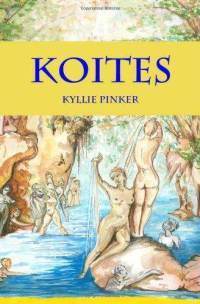
Today we will be giving away an ebook copy of this hilarious little book that pokes fun at sex and pornography! All you have to do to enter is read the entire post and leave a comment at the end about some facet of our discussion. Good luck to all!
Synopsis
A gender-bending tale about how modern day sex relationships came to
be. When Actaeon returns from the sea determined to marry his beloved Diana --
the greatest huntress and ruler-to-be of the land -- the Licentians in the
fabled land of Licentia are shocked. But Diana likes Actaeon too, so Licentians
stir up gossip, rumor, and betrayal to thwart their love. The shenanigans bring
Licentia to war, destroying, most terribly of all, the land's coupling
traditions, including the Barzexton, the Koites, and the Kunte. Written in
chronicle form, the story wanders through the voices of oeconomica specialist
Tantral, impecunious Pornog, and Jealomene who can only be a tailor, not a
huntress, because she lacks bushy armpits.
Review
If you enjoy light-hearted
stories with a touch of humor and satire, then Koites: An Ancient Myth About How Modern Day Sex Relationships Came to
Be by Kyllie Pinker will provide
you hours of entertaining fun. The author sweeps us into a fable about a place
named Licentia and a time long ago where desirable women sported bushy legs and
hairy arm pits and men shaved themselves hairless clean-shaven; where coupling
rituals were strictly controlled and women had the power to chose a mate best
suited.
Diana is a young woman being
primed for her mating ritual. Much to everyone’s chagrin, she chooses Actaeon,
a seafarer much disliked by the town folk. The fact that he bends the rules of
the Barzexton mating ritual where the males present themselves to Diana to
choose from, causes trouble and the entire village tries to keep the couple
apart.
The author has written a highly
imaginative, comedic story about sex. It is a satire of pornography and
intimacy, poking fun at men and women alike. The book itself is not lengthy and
makes for a fast read. The prose is very rich and colorful, adding to the
elegance of this little fable. Sexy, informative, funny, and delightful, there
is much to enjoy in this tiny book that packs a big punch!
Author Interview
Today I'm so pleased to have Kyllie Pinker who has kindly offered to tell us a bit more about herself and this comedic book that kept me chuckling from start to finish. Welcome Kyllie!
so much for
having me, Mirella!
1.
Welcome to
History and Women. Can you tell us a
little about your novel?
I wrote Koites as a comedic backstory to Ovid’s
famous myth about Actaeon and Diana. Ovid tells how Actaeon was turned into a
stag by the goddess Diana and then Ovid explains it all happened by fate. I’ve
created a fantasy story that scolds Ovid and says, “Are you kidding me?”
The novella begins
when Actaeon returns from the sea determined to marry his beloved Diana. She
now happens to be the greatest huntress and ruler-to-be of his hometown, called
Licentia. In the end, Actaeon doesn’t “get the girl” and instead, his presence
and his strange ways bring Licentia to ruin.
In between, we learn
that women in this land are huntresses with bushy armpits, while men are
clean-shaven and relegated to a life of child-rearing and homemaking.
2.
What
inspired you to write a novel about a woman in this period of history?
When I was a kid, I
had a love for ancient Greek and Roman mythology. My readings made me want to
travel extensively to the ancient ruins: Ephesus, Athens, and Delphi, for
example. I also lived in Naples, Italy for three years and spent a great deal
of time roaming the ancient ruins there, including Pompeii and the Phlegraean
Fields. The grand temples of the goddesses especially inspired my imagination,
so I really wanted to write a story set in mythical ancient times.
3.
What
hardships did women face in this particular century and what lessons can today's
woman learn from it?
Although scholars who
write about the history of ancient times show that women were kept out of
public life and forced to stay at home carrying out child-care duties, the
mythology points to a different world entirely. Goddesses were often equal to
men in strength, ruthlessness, jealousy, and compassion. Goddesses were also
very much in the public eye.
Greek and Roman myths
also centered around the notion of ‘fate.’ But I think we moderns believe less
in fate and more in choice. So I created a world in which there was a complete
role reversal of women and men and then I asked: What choices would boys make
under these circumstances? What choices would girls make if they had all the
power?
I blend the two
ideas, fate and choice, and then leave it up to women to make up their minds
about how much they impact their own roles in society today.
4.
What
inspired you about your heroine? Why did
you choose her?
I chose Diana because
I’ve always admired her in mythology. She is a huntress and also an independent
female who goes against the norm of what is considered proper for women in
ancient Greece and Rome. (And maybe even what’s considered proper for women
today.)
5.
Can you
describe a typical writing day?
I wake up, get the
kids off to school, and sit down at my desk. I write for several hours just
like someone who works at an office. It’s a pretty reliable and boring
schedule, really.
6. Can you tell us briefly about
your other novels and any new novels in the works?
Shshsh. It’s a
secret. J
I LOVE COMMENTS

From History and Women









Published on July 16, 2012 15:31
July 15, 2012
Women Who Ruled: Razia Sultana of India
By Lisa J. Yarde
History often reads a lot like “his story” - a list of exploits from the men who came, saw and conquered. It has its fair share of
powerful female rulers: Hatshepsut, Cleopatra VII and Elizabeth I. A consistent
theme is that most of these women lived in the sway of male influences, until
they met tragic, lonely ends. Women have exercised limitless influence in some
of the most unexpected places.
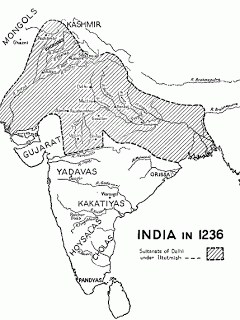
At a time when most Muslim women lived veiled and secluded in harems, many remarkable females made their bid for power. One among them was Razia, the eldest daughter of Sultan Iltutmish, who reigned in Delhi for 16
years until 1236. Educated and with a strong interest in politics, she became
her father's regent during his campaigns.On his deathbed, Iltutmish expressed his wish that Razia would rule in his stead, but this command offended the Indian nobles. Iltutmish insisted. “My two sons have given themselves up to wine, women, gambling and the worship of flattery. Government is too heavy for their shoulders to bear.
Razia, though a woman, has a man's head and heart and is better than twenty
such sons.”
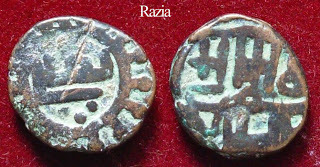
In defiance of their father's decree, Razia's half-brother Rukn-ud-Din Firuz, supported by the nobles and factions loyal to his mother Shah Turkaan, took the throne.Six months into the new ruler's reign, Razia appeared before the congregation at Friday prayers and spoke of the excesses of her half-brother. He was assassinated along with his mother. Supported by the masses, Razia ascended the throne of Delhi at the age of 31. During her four-year reign from 1236, silver coins issued in her name bore her official title “Jalauddin” but she referred to herself as “lmadatun Niwan”, which meant the Great Woman. Razia Sultana dressed like a man and rode an elephant through Delhi with her face unveiled.
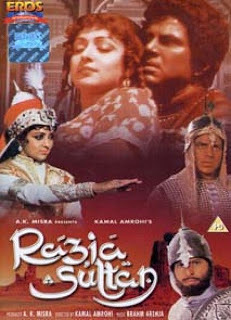
Rumors about her close relationship with an Ethiopian slave, Jamal-ud-Din Yaqut, caused her downfall. Her governors rebelled on the suspicion that her slave was her lover. They forced Razia to marry Malik Atunia, the governor of Bhatinda. However, the second of her
brothers, Muizuddin Bahram Shah, usurped the throne. Razia and her husband died fighting against him in October 1240. Her final resting place remains
a source of controversy; there are at least three sites where her body could
have been interred. Legends surrounding Razia have made her popular in Indian
culture; the 1983 Urdu film Razia Sultan is a fictionalized account of her life, as is Rafiq Zakaria's novel, Razia: Queen of India .
I LOVE COMMENTS

From History and Women










History often reads a lot like “his story” - a list of exploits from the men who came, saw and conquered. It has its fair share of
powerful female rulers: Hatshepsut, Cleopatra VII and Elizabeth I. A consistent
theme is that most of these women lived in the sway of male influences, until
they met tragic, lonely ends. Women have exercised limitless influence in some
of the most unexpected places.

At a time when most Muslim women lived veiled and secluded in harems, many remarkable females made their bid for power. One among them was Razia, the eldest daughter of Sultan Iltutmish, who reigned in Delhi for 16
years until 1236. Educated and with a strong interest in politics, she became
her father's regent during his campaigns.On his deathbed, Iltutmish expressed his wish that Razia would rule in his stead, but this command offended the Indian nobles. Iltutmish insisted. “My two sons have given themselves up to wine, women, gambling and the worship of flattery. Government is too heavy for their shoulders to bear.
Razia, though a woman, has a man's head and heart and is better than twenty
such sons.”

In defiance of their father's decree, Razia's half-brother Rukn-ud-Din Firuz, supported by the nobles and factions loyal to his mother Shah Turkaan, took the throne.Six months into the new ruler's reign, Razia appeared before the congregation at Friday prayers and spoke of the excesses of her half-brother. He was assassinated along with his mother. Supported by the masses, Razia ascended the throne of Delhi at the age of 31. During her four-year reign from 1236, silver coins issued in her name bore her official title “Jalauddin” but she referred to herself as “lmadatun Niwan”, which meant the Great Woman. Razia Sultana dressed like a man and rode an elephant through Delhi with her face unveiled.

Rumors about her close relationship with an Ethiopian slave, Jamal-ud-Din Yaqut, caused her downfall. Her governors rebelled on the suspicion that her slave was her lover. They forced Razia to marry Malik Atunia, the governor of Bhatinda. However, the second of her
brothers, Muizuddin Bahram Shah, usurped the throne. Razia and her husband died fighting against him in October 1240. Her final resting place remains
a source of controversy; there are at least three sites where her body could
have been interred. Legends surrounding Razia have made her popular in Indian
culture; the 1983 Urdu film Razia Sultan is a fictionalized account of her life, as is Rafiq Zakaria's novel, Razia: Queen of India .
I LOVE COMMENTS

From History and Women









Published on July 15, 2012 06:49



